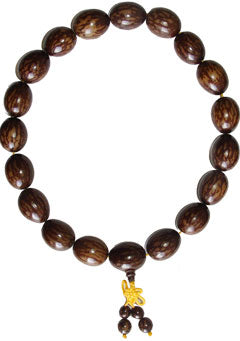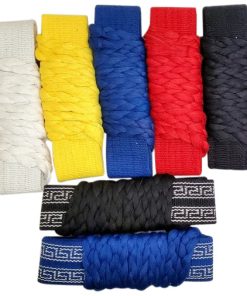Natural Nut Hand Beads Wing Lam Enterprises
$ 11,95 $ 7,17
In all Buddhist cultures, monks and lay practitioners use prayer beads or rosaries to help them count their prayers and incantations. In Sanskrit they are known as mala or Japa mala. They are usually round, but in some cases, they are carved in the form of human skulls, a reminder of the impermanence of life. Traditionally, Buddhist rosaries have 108 beads, representing the 108 human passions, or one mala counts as 100 mantras, and the 8 extra are meant to be dedicated to all sentient beings (the practice as a whole is dedicated at its end as well). Some smaller Chinese rosaries have 18 beads, one for each lohan. In Pure Land Buddhism, for instance, 27 bead malas are common. In China such malas are named “Shu-Zhu” (数珠 in Japan, “Juzu”. These shorter malas are sometimes called ‘prostration rosaries’, because they are easier to hold when enumerating repeated prostrations.
Even the beads that fasten the string together have a meaning: they symbolize the three jewels of Buddhism: the Buddha, the dharma (his teachings), and the Buddhist community. The string passing through the beads stands for the power of all the Buddhas that runs through everything.
Oval-shaped beads with a natural-grain look, polished smooth. 19 beads; 19 inches long; 1 inch bead
Fast Shipping and Professional Packing
Thanks to our longstanding association with UPS FedEx DHL and other top global carriers, we are able provide a range of shipping options. Our warehouse staff are highly trained and will be able to pack your goods in accordance with the exact and precise specifications. Your goods are thoroughly checked and properly secured before shipping. We ship to thousands customers every day from all over the world. This shows how we're dedicated to becoming the biggest retailer online in the world. The distribution centers and warehouses distribution are in Europe and the USA.
Orders that include more than one item are given processing time in accordance with the item.
Before shipping before shipping, we'll inspect thoroughly the items you've ordered. Today, most orders will be delivered within 48 hours. Delivery is expected to take between 3 and 7 days.
Returns
The stock is constantly changing. It is not managed entirely by us, since we are involved with multiple parties such as the factory and the storage. The actual inventory can change at any moment. It's possible that the stock may run out after your order has been placed.
The policy is for 30 days. If you have passed 30 days without a trace since the purchase and we are unable to offer an exchange or refund.
The item cannot be in use and must be in its original condition. You must have the item in the original packaging.







































